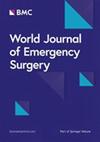Laparoscopic appendectomy as the gold standard: What role remains for open surgery, conversion, and disease severity?
IF 5.8
1区 医学
Q1 EMERGENCY MEDICINE
引用次数: 0
Abstract
Acute appendicitis is a common abdominal surgical emergency and is a major cause of acute abdomen in more than 20% of cases. Although various studies have been conducted in recent years on topics such as surgical techniques and antibiotic treatment of appendicitis, today there is a lack of large-scale studies focused on the different severity levels of acute appendicitis and their management. The study aimed to analyze the severity, types of surgical techniques, and mortality associated with acute appendicitis to identify possible developments. We conducted a retrospective multicenter observational study based on routine data from 2010 to 2022. Patients over 18 years old with acute appendicitis were included and the following data were collected: patient demographics, comorbidities, type of surgery, complications, admission to ICU, length of stay, and in-hospital mortality. A total of 31,988 patients were included in the study. At the end of the study, 97.0% (P < .001) of the patients underwent laparoscopic appendectomy, with 86% of cases involving closure of the appendix stump by stapler (P < .001). It was only from 2014 onwards that more than 90% of surgeries were performed laparoscopically, and from 2017, this figure rose to 95%. Complicated appendicitis was present in 27.4% of cases. The distribution of severity was as follows: unspecified acute appendicitis in 39.5%, appendicitis with local peritonitis in 33.1%, appendicitis with local peritonitis and perforation in 17.1%, appendicitis with peritoneal abscess in 5.4%, and appendicitis with generalized peritonitis in 4.9%. Women had a significantly lower risk for conversion to an open operation than men (P < .001). The highest morbidity was observed in the group that converted from laparoscopy to open surgery (P <.001). Non-surgical treatment of appendicitis was not relevant, accounting for only 4% of cases. Since 2017, primary laparoscopic appendectomy has been the gold standard for even complicated acute appendicitis (> 95% annually). Over three-quarters of patients undergo an appendectomy with a stapler, making this surgical technique the preferred method of laparoscopic surgery in Germany. Patients who undergo an interoperative switch to open therapy should be considered a subgroup at risk of increased mortality. ClinicalTrials.gov ID: NCT06558760.作为金标准的腹腔镜阑尾切除术:开放手术、转换和疾病严重程度还有什么作用?
急性阑尾炎是一种常见的腹部外科急症,是20%以上的急腹症的主要病因。尽管近年来对阑尾炎的手术技术和抗生素治疗等主题进行了各种研究,但目前缺乏针对急性阑尾炎不同严重程度及其治疗的大规模研究。本研究旨在分析与急性阑尾炎相关的严重程度、手术技术类型和死亡率,以确定可能的发展。我们基于2010年至2022年的常规数据进行了一项回顾性多中心观察研究。纳入18岁以上急性阑尾炎患者,收集以下数据:患者人口统计学、合并症、手术类型、并发症、ICU入院情况、住院时间和住院死亡率。该研究共纳入31988名患者。研究结束时,97.0% (P < 95%)。超过四分之三的患者使用订书机进行阑尾切除术,使这种手术技术成为德国腹腔镜手术的首选方法。接受手术转换为开放治疗的患者应被视为死亡率增加风险的亚组。ClinicalTrials.gov ID: NCT06558760。
本文章由计算机程序翻译,如有差异,请以英文原文为准。
求助全文
约1分钟内获得全文
求助全文
来源期刊

World Journal of Emergency Surgery
EMERGENCY MEDICINE-SURGERY
CiteScore
14.50
自引率
5.00%
发文量
60
审稿时长
10 weeks
期刊介绍:
The World Journal of Emergency Surgery is an open access, peer-reviewed journal covering all facets of clinical and basic research in traumatic and non-traumatic emergency surgery and related fields. Topics include emergency surgery, acute care surgery, trauma surgery, intensive care, trauma management, and resuscitation, among others.
 求助内容:
求助内容: 应助结果提醒方式:
应助结果提醒方式:


